
William Bligh
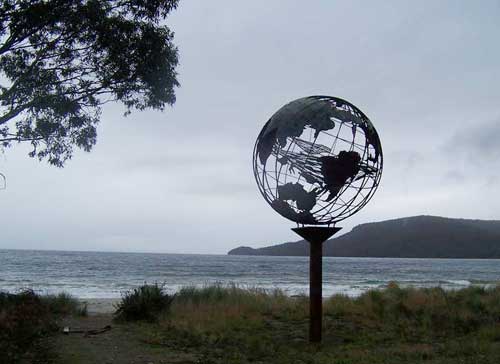
Memorial to Bligh and other mariners at Adventure Bay, Bruny Island, Tasmania
At 22, to be appointed sailing master on a major research vessel was a great tribute to his skill and connections. The Resolution and Discovery included a visit to Adventure Bay, Tasmania where they planted fruit trees, which are believed to include the first apple trees planted in the Huon valley. Cook was killed in Hawaii later in the expedition and it was left to Bligh to brings the ships home. The voyage ended in late 1780, and Bligh took a 12-month leave from active duty, during which time he was married.
The success he had in finding plenteous supplies of water and timber during their week long sojourn at Adventure Bay on Tasmania's Bruny Island in late January 1777, combined with the peacefulness of their communication with the Tasmanian aborigines they encountered must have made its mark on Bligh's mind, as he would return to the bay a number of times again.
After serving on a number of ships, in June 1783 Bligh entered the service of Sir Duncan Campbell in the West Indian trade. He remained in the Jamaica trade for four years, his last assignment on board the Brittania, where he was to meet Fletcher Christian an others who were to sail with him on the Bounty. It was on this voyage, to collect breadfruit plants from Tahiti and take them to the west Indies, that Bligh was cut adrift in the ship's longboat by Christian in the inamous mutiny on the Bounty of 28 April 1789. Bligh's skills as a navigator of the highest quality was demonstrated by his ability to sail the Bounty's lifeboat, which was just 7 metres long, from the island of Torfoa to the island of Timor, a distance of 5,800 km, with only a sextant as a navigational aid.

Resolution Creek, Adventure Bay, Tasmania
William Bligh first visited Van Diemen's Land Tasmania) in 1777, with James Cook on HMS Resolution. Bligh, a young navigational officer, had a great sense of location and navigational ability. He had been appointed Master of Resolution, commanded by James Cook, at the age of 22, and would accompany Cook throughout his third and final voyage of discovery into the Pacific. Cook never completed the voyage - he was killed in Hawaii - and it was Bligh who took Cook's place to bring the expedition safely home.
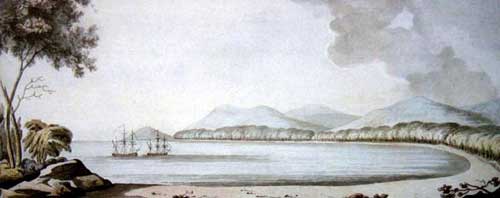
Above: Adventure Bay, Bruny Island, as recorded by William Ellis, surgeon's mate aoard the Discovery in 1777. Below: the same scene today

The success they had in finding plenteous supplies of water and timber during their week long sojourn at Adventure Bay on Tasmania's Bruny Island in late January 1777, combined with the peacefulness of their communication with the Tasmanian aborigines they encountered must have made its mark on Bligh's mind, as he would return to the bay a number of times again.
Bligh, the Bounty and Adventure Bay
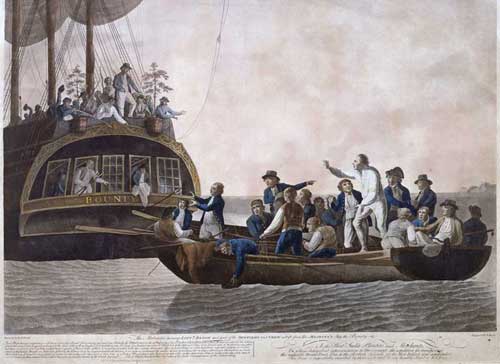
Munity on the Bounty
Prior to the mutiny and eleven years after his first visit, Bligh sailed HMS Bounty into Adventure Bay in Tasmania and dropped anchor on 19 August 1788, needing fresh water supplies and wood for the ship's fires. Bligh watered his ship with fresh clean water in a gully that was dry on his previous visit with Cook. The ship's crew included a botanist, David Nelson, lost no time in going ashore to collect botanical specimens. Fletcher Christian, who would later lead the famous mutiny against Bligh, was in charge of the shore party and he took this opportunity to augment Nelson's collections with his gun. He shot a number of birds, one of which Bligh identified as "a very beautiful plumaged bird which we call the Lauryquet, being longer than a Parroquet but it had nearly the same colours only the blue & red was rather more brilliant." A pod of whales cavorting in the bay escaped a similar fate only because the ship's armoury did not include any "proper harpoons for them."
On board the Bounty was a nursery of fruit trees which Bligh had acquired at the Cape of Good Hope. With the help of Nelson he "chose what we thought the safest situations, and planted three fine young Apple-Trees in a growing State, nine Vines, six Plantains, a number of Orange and Lemon seed, Cherry stones, Plum stones, Peach, Apricot & Pumpkins, also two sorts of Indian Corn, and Apple and Pear pips" in order "to do good the most in our power to the Natives or those who may come after us."
Bligh was concerned to make contact with the Aborigines but in this he was, for a time, frustrated. It was a fortnight before he saw sign of them and this was only in the distance through his telescope. Eventually he set out in the ship's longboat to where several fires had been seen near the shore. It was not long before a group of about twenty men and women emerged from the bush making "a prodigious chattering of speech."
Owing to a heavy surf it was not possible to land and he was restricted to throwing presents tied up in paper to them. Nevertheless from a distance of twenty metres he was able to observe them in some detail. "They were certainly woolly headed", he noted, "as much as even a Negroe was. Their teeth appeared remarkably white - They run very nimble over the rocks. They talked to us sitting on their heels with their Knees close in to their Arm Pits. They have a quick eye, as they caught small Nails and beads I threw at them with some cleverness".
On 4 September the Bounty weighed anchor and put to sea. On board were a variety of plants which Nelson had carefully collected, some 70 of which "were either new or valuable." The celebrated mutiny took place on 28 April the following year - Bligh was set adrift in a longboat with eighteen others. He navigated the remarkable 6,400 km to Timor in a longboat. It would be another eleven months before Bligh returned to England. After being acquitted by court-martial for the loss of the Bounty he was offered the command of HMS Providence and Assistant with orders to complete the transfer of breadfruit trees from Tahiti to the West Indies.
Adventure Bay, 1792
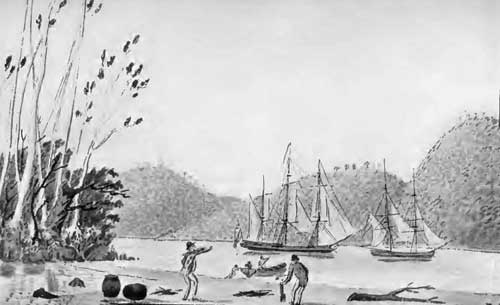
The "Providence" and "Assistant" at Anchor in Adventure Bay. Drawn by Lieut. G. Tobin, 1792.
After the Bounty voyage, Bligh commanded a number of scientific voyages. In November 1790, at the recommendation of Sir Joseph Banks, Bligh led another expedition to transplant breadfruit plants from Tahiti to the West Indies. With another of Cook's understudies, Lieut. William Portlock, Bligh set sail aboard the brig Assistant from Portsmouth in August 1791. This time, Bligh completed the mission to collect breadfruit trees and other botanical specimens from the Pacific, which he transported to the West Indies. Specimens were given to the Royal Botanic Gardens in St. Vincent. Providence returned to Britain in August 1793, having been re-rated as a sloop on 30 September 1793.
During the voyage, Bligh made a return visit to Van Diemen's Land, anchoring once again in Adventure Bay in February 1792. Parties were immediately sent on shore for wood and water. Lieut George Tobin, a talented artist, was greatly impressed by the giant Tasmanian blue gums fringing the bay. He measured one that was 29 feet in girth and noted that "the trunks grow to a great height before they branch out; the leaf is not long and not unlike a peach, and the bark is light-coloured and has the appearance of having been peeled." He added, " I saw no signs of any ships having been here, and the trees I marked remained the same as I had left them in 1788".
Bligh was disappointed to find that, of the fruit trees he had planted on his previous visit, only one apple tree had survived. It had not grown at all but was still in a healthy state and he had hopes that it would eventually produce fruit. His lack of success as a gardener did not stop him from planting nine oak trees as well as sowing more fruit stones and some fir seed. A cock and two hens were released into the bush in the hope that "they would breed and get wild" although their chances of evading the Aborigines were not rated very highly.
Bligh's curiosity led him to explore a small lake at the back of the beach in one of the ship's boats. Although its water was brackish it was plentifully stocked with fish, particularly bream, "of which we caught seven in a few minutes with Hook and line." The lake also supported a large variety of birds including wild ducks, pelicans, black swans and herons.
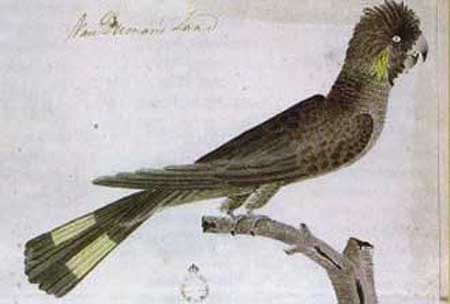
Black cockatoo from the sketch book of William Bligh
One of the "Young Gentlemen" shot a cockatoo which Bligh described in some detail: "the plumage was brown tinged with black & olive, on each side of the head a yellow spot. Six of the long tail feathers were yellow speckled with black, about 3 inches in the middle, so that when they flew it formed a circular yellow mark." It was probably a variety of the Banksian cockatoo. Gannets were also a favourite of Bligh's but for a different reason - "Roasted with its skin off (it) is preferable to any of the others, & is remarkably free of any fishy taste."
During their excursions to different parts of the Bay kangaroos were often seen by the visitors but none were killed as they always managed to escape into the dense undergrowth. "A good Dog would give a great deal of sport", lamented Bligh. Other animals he took note of were a "rat" with a head like a mole and a type of lizard called by the seamen a "Gally Wasp." It was black in colour, spotted with yellow; its had was flat with a large mouth and a thick blue tongue.
But perhaps most peculiar of all was a creature shot by Lieutenant James Guthrie. "It had a beak like a Duck - a thick brown coat of Hair through which the points of numerous Quills of an inch long projected and were very sharp. It was 17 inches long & walked about 2 ins. from the ground. Had very small eyes and fine claws on each foot. The mouth was a small opening at the end of the Bill & had a very small tongue." Despite the misleading reference to a duck bill this "animal of very odd form" was not a platypus but an echidna.
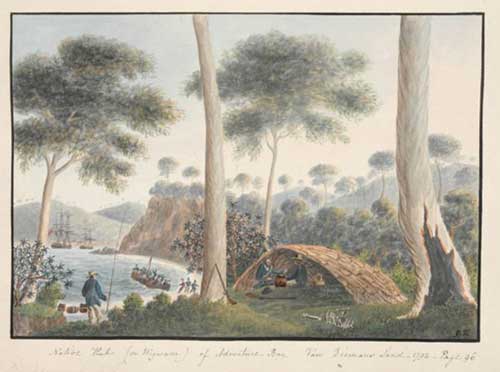
Naval lieut George Tobin's sketch of an aboriginal dwelling at Adventure Bay, drawn in 1792
Once again the Aborigines proved to be very elusive but on 19 February a part of Bligh's men unexpectedly met a group of 16 men and 6 women. "There was so much suspicion on both sides, mixed with fear, that their interview was very short." All Bligh learned was that the men were named and had thick bushy beards while the women wore a covering of skin over their bellies. On another occasion Bligh was intrigued to note that the only thing they coveted was a hat - "trinkets, such as rings, that were given to them, they returned." He also observed that they seemed to have an aversion to "being wet with the sea." While gathering mussels "the men flew away from every surge of the water, which would not have reached their knees."
Bligh's departure from Adventure Bay was delayed when it was discovered that one of the crew was missing. Signal fires were lit, search parties were sent out and eventually the man was found. "It is wonderful to relate", wrote Bligh, "that this unhappy creature has determined to stay behind with a wish to perish and never to return to his Native Country. I found he was of creditable parents, but had been a Disgrace to them, therefore they had recommended him to go on this Voyage, as the most likely means of either improving or destroying him".
After two weeks of exploring, sketching and planting fruit trees, he left the bay for Tahiti where he learnt of Capt. Edwards voyage aboard HMS Pandora to round up the Bounty mutineers. Bligh took on board 2,196 breadfruit plants and left, visiting Fiji and spending 3 weeks charting and sketching the intricate channels and islands of Torres Strait on his journey to the West Indies. Bligh's second lieutenant, believed to be Matthew Flinders, went ashore on North Possession Island in Torres Strait and took possession of all the islands of the strait in the name of King George III. Bligh returned to England in August 1793.
Late in 1796, he was appointed commander of HMS Director. It is also interesting that in 1797, Bligh was involved in another serious mutiny, known as the Mutiny at the Nore. The crews of a number of naval vessels, including the Director, under the command of Vice-Admiral Buckner, mutinied together. It was a bloody and violent struggle. At its conclusion, Bligh stood strongly behind his ship's crew, and was commended by both seaman and officer alike for his handling of the affair.
He returned to England in 1790 and continued his career in the navy. Captain William Bligh was invited to survey Dublin bay by the director general of inland navigation. He had a reputation, earned in the South Seas, as a marine surveyor. He arrived in Dublin in September 1800 and commenced work immediately. He completed his survey and report in 3 months. Bligh returned to his naval duties in early 1801 and fought with Admiral Horatio Nelson at the battle of Copenhagen in that year.
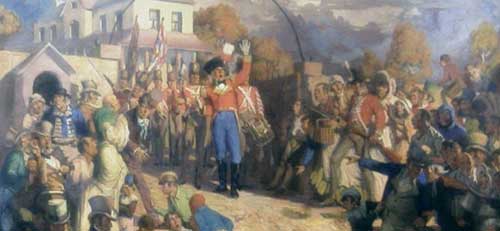
The Rum Rebellion, 1808
Through the support of Sir Joseph Banks, he was offered the Governorship of the colony of New South Wales and took up the post in 1806. Within weeks of his arrival in August 1806, Bligh had made it clear he would not tolerate the corruption of the NSW Corps and vowed to destroy their control of the importation of spirits and domination of economic life in the colony. He brought the matter to a head by arresting free settler John Macarthur over his previous actions in resisting a warrant issued against him. Outraged by Bligh's actions, a unit of the NSW Corps led by their Commanding Officer Major George Johnston who was sympathetic to MacArthur marched on Government House in Sydney on 26th January 1808 and demanded Macarthur's release. When Bligh refused he was placed Bligh under house arrest.Lieutenant-Colonel Joseph Foveaux become acting lieutenant-governor in July 1808. Since a decision on Bligh was expected from England, and feeling that Bligh's behaviour had been insufferable, Foveaux left Bligh under house arrest. When there was still no word from England, he summoned Col. William Paterson to Sydney in January 1809 to sort out matters. He confined Bligh to the barracks until he signed a contract agreeing to return to England. In January 1809 Bligh was given the control of HMS Porpoise, a ten-gun store ship, on condition that he return to England. However, Bligh sailed to Hobart, Tasmania, seeking the support of the Tasmanian Lieutenant-Governor David Collins to retake control of the colony. Collins did not support him and on Paterson's orders Bligh remained cut off on board the Porpoise, moored at the mouth of the River Derwent south of Hobart, until January 1810.
Hearing that Brigadier General Lachlan Macquarie had taken over as governor on 1 January 1810, Bligh sailed to Sydney, arriving on 17 January 1810 to collect evidence for the forthcoming court martial of Major George Johnston. He departed for the trial in England on 12 May, arriving on 25 October 1810 aboard the Hindostan.
The Home Government was very unsympathetic to the rebellion; Johnston was court martialled, leading to his dismissal from the Army, and John Macarthur who returned to England in 1809 was forbidden to return to Australia until 1817. Bligh was cleared of any wrong doing and continued his career in the navy. He was promoted to Rear Admiral in 1811 and Vice Admiral in 1814. He died in London three years later.
 Encounters at Adventure Bay
Encounters at Adventure Bay